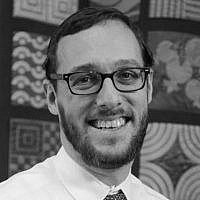MAR 4, 2021, 5:42 PM
The Times of Israel
I coined a new halakhic term this Purim, in the spirit of the Midrash on Yeshayahu (51:4). “A Torah will go forth from Me.” Noting the future tense of “will go forth,” Rabbi Avin bar Kahana explains, what is this Torah that will come forth from God? It’s a torah chadasha, a new Torah, or chiddush, an innovation, that until now did not exist in this world. Or in the succinct words of Rav Kook: הישן יתחדש והחדש יתקדש, we are living in an era when the old will be made new, and the new will be made sacred.
In that vein, here’s the NEW halakhic category: along the lines of the famous concept of שומע כעונה, HEARING is like articulating, I think it’s legitimate to also say רואה כעונה, SEEING is like articulating.
Allow me, please, to explain.
In recent months, our class spent a lot of time looking into the halakhic status of the deaf-mute person. Mostly we were trying to figure out how halakha should respond to the fact that today’s deaf-mute person is neither deaf nor mute in the same way as in days gone by. Science has enabled them to overcome every barrier to hearing or speaking — in the sense of receiving and conveying communications — through the use of hearing aids, cochlear implants, lip-reading, and sign language.
This raises a question: does this mean that the halakhic חרש no longer exists? A halakhic חרש is one who can’t hear or speak. Today, such a person no longer exists.
This question plays itself out in many halakhic arenas, and Megillah-reading is among them.
Here’s how:
One of the big halakhic questions regarding these advancements is the status of sign language: is it halakhically considered a valid language for any area in Jewish law that requires speech? I believe the answer is affirmative. Some of us speak English, some of us speak Urdu, and some of us speak sign language. It is just one more language. True, the way it is spoken is a little different from the way other languages are spoken, but so what? Why should that matter?
Even if you disagree with me on this, indulge me for a moment so that you can help me explore a hypothetical.
Assuming I am right and sign language indeed does have the halakhic status of a “real” language, it would follow that a Megillah scroll that tells the Purim story in sign language would be kosher. (The halakha is that a Megillah can be written in any language.) One who knows sign language would then be able to be yotzei the mitzvah or kri’at Megillah by reading the Megillah “out loud” physically, through signing.
This part is simple and pretty straightforward. Here is the question, though: would he (or she) be able to be motzi others as well? Would someone who watches the signer tell the story of the Megillah through movements be yotzei by employing the concept of רואה כעונה, seeing is like articulating?
I would think that it should be no different from שומע כעונה, HEARING is like articulating.
Essentially, the idea behind שומע כעונה is that one can do a mitzvah vicariously by employing a bodily capability other than speaking. Hearing that which needs to be pronounced is halakhically valid, just as if one had actually pronounced those words. If that’s true for hearing, why should it not also be true for seeing?
I don’t see why there should be a difference between these two senses. If hearing can halakhically work in lieu of articulating (שומע כעונה), so too should seeing be able to accomplish that (רואה כעונה).
What do you think?
(Below: click on the link for a touching clip of a deaf-mute couple using sign language to teach their little child the brachot for lighting chanukah candles. I dare you not to cry)
״וְהַיָּמִים הָאֵלֶּה נִזְכָּרִים וְנַעֲשִׂים בְּכָל דּוֹר וָדוֹר
מִשְׁפָּחָה וּמִשְׁפָּחָה…״חנוכה שמח! pic.twitter.com/YXWh4jPAwA
— שירלי פינטו Shirly Pinto (@ShirlyPinto) December 23, 2019
ABOUT THE AUTHOR Rabbi Ysoscher Katz is the Senior Rabbi of PHS, a Modern Orthodox congregation in Prospect Heights, Brooklyn, and Chair of the Talmud department at Yeshivat Chovevei Torah. He received ordination in 1986 from Rabbi Yechezkel Roth, dayan of UTA Satmer. Rabbi Katz studied in Brisk and in Yeshivat Beit Yosef, Navaradok for more ten years, and is a graduate of the HaSha’ar Program for Jewish Educators, Rabbi Katz taught at the Ma’ayanot Yeshiva High School for Girls and SAR High School, and gave a popular daf yomi class in Brooklyn for more than eight years.
Source: blogs.timesofisrael.com/new-halakhot-for-the-new-reality-of-todays-cheresh-the-deaf-mute-person/




